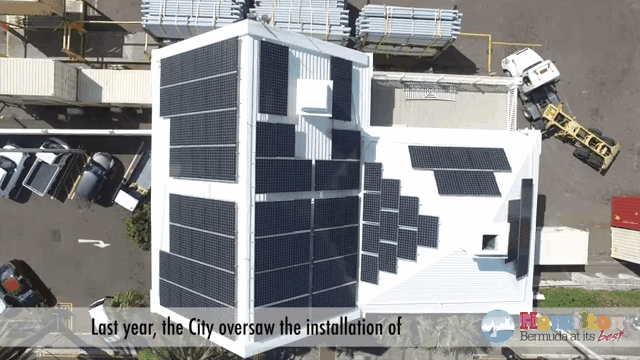Video: City Of Hamilton Highlights Pump Station
As we mark Earth Day today, April 22, the City shares its plans for the Front Street pump station, aimed at reducing the amount of microplastics and bacteria that are expelled into the ocean via our wastewater.
Public Relations Manager Helen Zoellner said, “It may not look like much from the outside, but the City’s Front Street Pump Station has a very important albeit very dirty job to do! It processes Hamilton’s sewage totaling about 500,000 – 600,000 gallons per day and pumps it over the Seabright outfall on South Shore.
“Last year, the City oversaw the installation of 78 solar panels here at the pump station which, it is anticipated, will save the City more than $30,000 a year on electricity costs. The energy needed for the pump station does more than just power the moving of sewage through the pipes, it also powers the screening machine, the sewage monitoring system, and the pump station’s communications hub.
According to City Engineer Patrick Cooper, the City spends more than a $200K each year on electricity costs for this pump station alone.”
City Engineer Chief Operating Officer Patrick Cooper said, “This pump station runs 24/7. And as you can imagine it has a huge electrical load. The solar panels really help to reduce our baseload amount, and substantially lower our Belco bills.”
Ms. Zoellner said, “The City already has a significant solar panel installation at its Works Depot and has plans for further installations on some of its other buildings including Pier 6. And even more changes are ahead for our pump station, all aimed at creating a greener island.
“The City has plans to purchase two micro screening machines which will remove 40 per cent of suspended solids from the City’s wastewater.”
Mr. Cooper said, “In 2015 the City carried out a refurbishment of the existing wastewater filtering screens and reduced the perforated plates from 6mm to 3mm, preventing any solids more than 3mm in size from being discharged from the outfall.
“The two new micro screens we will install are even more restrictive against solids, preventing anything over 0.35mm from passing through them. Once we get these new screens installed, they will prevent 1,210 liters of solids per day from going into the outfall, this is essentially a large dumpster of solids a day.”
Ms. Zoellner said, “The implementation of this two-stage screening system will lead to a significant reduction in the amount of macro and micro plastics entering the ocean at the South Shore outfall. These plastics can enter the sewer system through incorrect disposal of plastic materials, through the use of personal care products containing micro-beads, and through the laundering of clothing containing plastic fibers, such as polyester.
“The City will also introduce a peracetic acid [PAA] disinfection process on the wastewater prior to it being expelled through the Seabright outfall, which will significantly reduce the levels of bacteria in the waste, helping to further safeguard the quality of our bathing water which is already within regulatory standards. PAA is safe for the environment with essentially no harm to coral reefs or aquatic life. It has been used at numerous wastewater facilities in coastal areas across Europe for protecting water quality used by recreationalists. As the use of PAA disinfection can be costly, it will only be carried out during bathing season, from April through October.
“To learn more about the City’s green initiatives go to their website www.cityofhamilton.bm.
Read More About
Category: All, Environment, News, Videos


